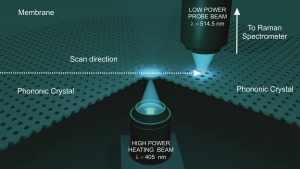Photomechanical Hybrid Membranes Nanomechanics
Supervisory institution: Foundation for Polish Science (FNP)
OVERVIEW: The last four decades have witnessed tremendous progress in the miniaturization of everyday electronic, optical and mechanical devices.
Nowadays, flexible structures made out of atomic monolayers and ultrathin membranes are expected to be the next gamer-changer. MoS2
among others offers unique optical, electronic, thermal, and mechanical properties. Nevertheless, the inevitable defects ruin their intrinsic
strength and lead to fragility. This remains a critical bottleneck in successful large-scale applications.
AIM: In this project we want to overcome this issue by reinforcing ultrathin membranes with a polymer skeleton mimicking a bone-joint scheme and dedicated architecture. We aim to use this composite and build a novel light-stimulated actuator and a light-driven acoustic filter. As a prerequisite we will develop and perform contactless measurements and engineer the nanomechanics of the components, their interfaces and of the nanocomposite.
Phononic Crystals for Heat and Sound Nanodevices
Supervisory institution: Foundation for Polish Science (FNP)
OVERVIEW: Sound and heat in solids propagation, commonly understood as separable phenomena, both originate from the transport of the lattice vibrational energy via wave-packets showing particle-like behavior. These quasi-particles, phonons, similarly as other everyday particles: photons and electrons can be considered as energy and information carriers. The research from the last decades shows successful management of electromagnetic waves and electrons at the micro-and nanoscale, which was gladly transferred into applications and devices operating in a wide range of energies. Similar efforts deployed, notably in the framework of a new research field of nanophotonics, attempt to achieve a comparable degree of control over GHz and THz phonons accounting for the hypersound and heat transport, respectively. Nowadays, the most important challenges facing this field are the development of GHz-THz coherent phonon sources, waveguides, radiofrequency devices, and acoustic and thermal diodes, progress in the efficient thermal management for the continued miniaturization of electronics, energy harvesting and waste heat recovery, enhancement of photon-phonon interaction in optomechanics, and investigation of new state variables for future information and communication technologies (ICT). All these challenges open many fundamental questions and at the same time give many opportunities for GHz-THz phonons management with unprecedented accuracy. The phenomena of sound and heat flow are fundamental issues of basic research as well as a key problem of many everyday technological applications. The need for high-frequency phonons management arises from new challenges brought by the quest for continuous improvement and miniaturization of nanodevices. Although the transport of vibrational energy has been studied for centuries the advent of nanotechnology has induced new research attempting to revise fundamental features of sound and heat at the nanoscale.

AIM: The project aims to give a new insight into the sound/heat propagation altered by nanoscale periodic patterning of quasi-2D materials. In particular, the objectives are: (i) to design and fabricate PnCs based on Si membranes of a feature size from 100 to 1000 nm, (ii) to determine the reduction of the thermal conductivity in Si PnC membranes as a function of the surface to volume ratio, (iii) to determine the temperature dependence of the thermal conductivity in a range of about 300-1000 K, (iv) to investigate the influence of the coherent effects, i.e. modified phonon dispersion, local resonances, possible phonon band gaps on the thermal conductivity, (v) to investigate the influence of the structure imperfections, surface roughness, presence of the native oxide on the thermal conductivity, (vi) to investigate and quantify air convective losses in Si membranes and PnCs, (vii) to ascertain the role of controlled disorder on the GHz-THz phonon transport and possible (Anderson) localization in PnCs. To address all the above objectives the project proposes a systematic investigation including the design supported by the finite element method and nanofabrication performed using the technological processes of silicon. The Samples will be characterized by means of novel non-destructive and contactless techniques based on inelastic light scattering – Brillouin (hypersound) and Raman (heat) Spectroscopy.
FUNDING



